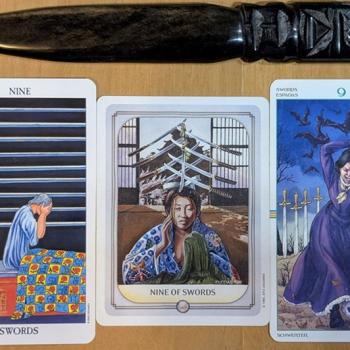Pinocchio (1940)
Directed by Ben Sharpstein and Hamilton Luske: Although Snow White has a better score, Pinocchio, the second of Disney's animated features, is the most beautifully drawn. In excitement and invention, the scenes in the whale's belly surpass anything ever done by the Disney studio, even with the aid of computer graphics. Like the story of Jonah, its distant ancestor, Pinocchio graphically portrays both the consequences of sin and the grace of redemption.
The Quiet Man (1952)
Directed by John Ford: Almost all of Ford's best films qualify for this list. Here he shows an Irish-American prizefighter (John Wayne) who, having killed a man in the ring, attempts to retire peacefully to rural Ireland. But having wooed and won Maureen O'Hara, he discovers he must fight her bully brother, Victor McLaglen, to liberate her and win the respect of the community. Filmed in a lyric, comic style, this film, like My Darling Clementine and The Man Who Shot Liberty Valance, explores a favorite Fordian theme: the uneasy relationship between civilization, or law, and violence.
Quiz Show (1994)
Directed by Robert Redford: Countless films reveal the folly of the world, but among recent ones Quiz Show stands out. Its script by Paul Attanasio, who also wrote Donnie Brasco, accurately depicts the process by which all of us, however well meaning, are capable of sliding backward on the plane of life.
Rome, Open City (1945)
Directed by Roberto Rossellini: Shot in part before the Nazis had even left Rome, this film poignantly shows partisan and priest in their efforts at resistance. The death of the pregnant Anna Magnani and the martyrdom of the priest remain two of the most memorable moments in all cinema.
The Sign Of The Cross (1932)
Directed by Cecil B. DeMille: Max von Mayerling said that there were three great directors -- himself, D. W. Griffith, and Cecil B. DeMille. When one sees this epic, one understands why. It combines the style of the best silent films with the intelligence of the newly imported Broadway writers, in this case Sidney Buchman, future creator of Mr. Smith and Mr. Jordan. It is so visually stunning that it might be mistaken for a work by Von Sternberg or Lubitsch, the other two creators of the famed Paramount style of the early '30s. Claudette Colbert's sensual bath in asses' milk seems decorous today, and the film has the virtue of rewarding its hero and heroine, Fredric March and Elissa Landi, with martyrdom. The prurience of the original version helped form the Legion of Decency, but the version shown on TV is the one cleaned up by the Production Code Administration and omits gratuitous sensuality while retaining the story's essential Christianity.
The Song Of Bernadette (1943)
Directed by Henry King: Hollywood's most Catholic film, a fact that I attribute to wartime suffering and austerity. As Bernadette (Jennifer Jones) goes off in a cart to the nunnery, her suitor kneels by the roadside, left at home to keep the faith, not unlike the reversed situation of women saying final farewells to their men going off to war.
Thérèse (1986)
Directed by Alain Cavalier: Done in the style of Dreyer and Bresson, this film succeeds in presenting the essence of the life of the Little Flower.
Three Godfathers (1948)
Directed by John Ford: This work by Ford is not as admired as it should be, perhaps because it is so obviously a Christmas story. In it, Ford already pays homage to the whole history of the western, as he tells the story of two desperados who, joined by John Wayne, try to keep a baby alive as they cross the desert pursued by a posse, led by a non-killing sheriff (Ward Bond). Sophisticates may sneer, but it made me cry.
Voyage To Italy (a.k.a. The Strangers) (1953)
Directed by Roberto Rossellini: An English couple (George Sanders and Ingrid Bergman) travel to Italy in an attempt to repair their failing marriage. As Emerson warned, they carry "ruins to ruins," and the film captures, through the beauties of Naples and the surrounding countryside, the emptiness of their relationship and the reasons for it. At the end, when they witness a miracle, they rediscover their love for one another. Some critics think the ending ironic, as in La Notte. But Rossellini, unlike Antonioni, consistently made profound Catholic films. Bergman, possibly the greatest of all movie actresses, appears here at the height of her powers.
You Can't Take It With You (1938)
Directed by Frank Capra: Capra improves the Kaufman and Hart play, which reconciles class conflict through zaniness and the marriage of children. The scene in which Lionel Barrymore and Edward Arnold play "Polly Wolly Doodle" on their harmonicas may be the essence of "Capracorn," but the music conjures up the lost children and is the closest thing I know in film to the resurrection of Hermione in The Winter's Tale.



